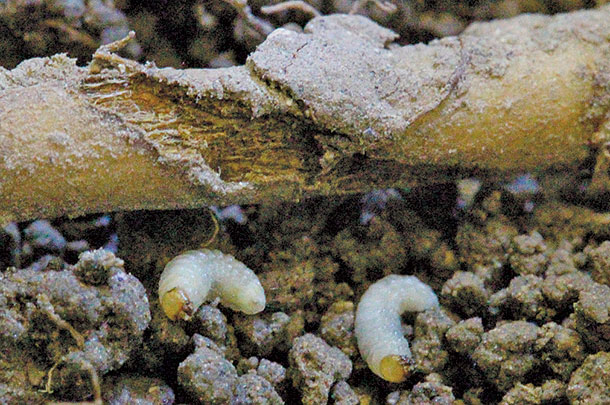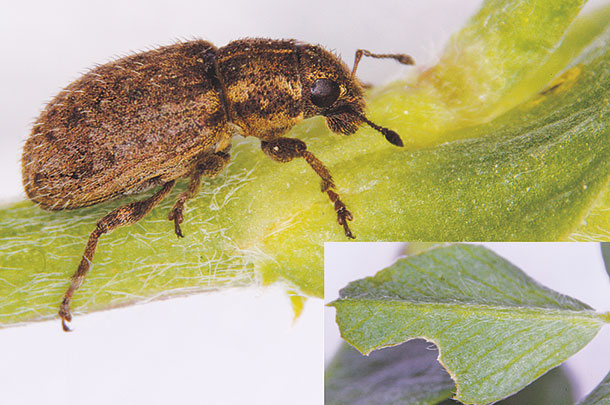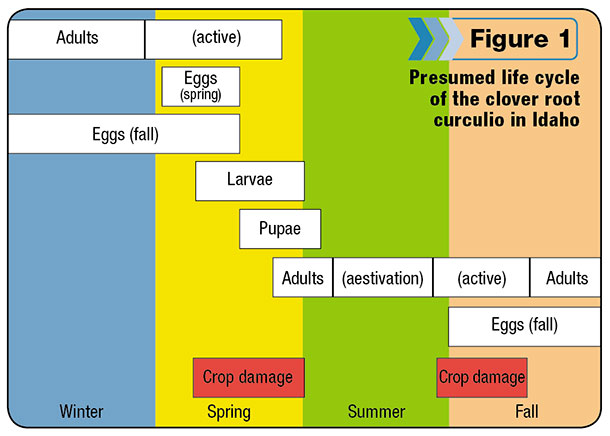No insecticides are registered against the larval stage of clover root curculio in alfalfa in the Pacific Northwest, and insecticides used against adults are not likely to provide effective control. Management of this pest primarily relies on cultural control practices, including crop rotation.
This article will help you to identify clover root curculio infestations and to design an integrated pest management (IPM) program for managing clover root curculio in alfalfa.
The IPM approach combines cultural and other control methods with field scouting in order to reduce the need for chemical controls. Alfalfa growers who use IPM can increase profits while reducing potential harmful effects associated with pesticides.
Pest description
Clover root curculios develop through four life stages: egg, larva, pupa and adult.
- Eggs are nearly round and less than 1/64-inch (0.36 mm) in diameter. White to yellowish when first laid, they turn shiny black within about three days.
- Larvae are white, legless, brown-headed grubs that are about 1/32-inch (0.7 mm) long when they first hatch and about 1/4-inch long when mature (Photo 1).

- Pupae are white to yellow and about 5/32-inch (4 mm) long.
- Adults are 9/64- to 3/16-inch (3.5 to 5 mm) long with a grayish body and a short, broad snout (Photo 2).

Clover root curculios are beetles in the weevil family (Curculionidae). Adults are similar in size and color to pea-leaf weevils but lack the pea-leaf weevil’s dark lines running down the length of the wing covers and hairs that lay flat on the wing covers. Instead, clover root curculios have hairs on their wing covers that stand erect and are curved slightly toward their hind ends (Photo 2).
Clover root curculios can be distinguished easily from alfalfa weevils and clover-leaf weevils because the latter two pests are larger and have longer, more slender snouts. In addition, these two species feed within or on plant foliage during the larval stage, whereas clover root curculio larvae feed on roots.
Life cycle
The presumed life cycle of the clover root curculio in Idaho is based on information from the eastern U.S. (Figure 1).

Clover root curculios overwinter primarily in the adult stage; adults become more active in the spring when temperatures exceed 50ºF (10ºC).
Most eggs are laid during the spring. Eggs are laid on the soil at the base of plants, under leaf litter or on the stems or leaf stipules of plants.
Spring-laid eggs hatch in 2.5 to three weeks, and larvae develop through five instars, or stages, over three to five weeks. This is the period when the clover root curculio is most damaging to alfalfa.
Larvae pupate, and the next generation of adults emerges around June to July. The complete spring life cycle, from egg to adult, may take 40 to 50 days.
During the warmest part of the summer (mid-July until probably September), adults go through a period of aestivation (i.e., summer dormancy), which may occur outside of alfalfa fields. During the fall, adults return to alfalfa fields, mate and begin laying eggs.
Cold weather causes females to cease egg laying, and most eggs are laid the following spring, with egg-laying activity increasing whenever temperatures exceed 50ºF. Females may even lay eggs during warm winter days.
Damage and host plants
Clover root curculios feed on alfalfa (Medicago sativa) and many clover species (Trifolium spp.), as well as on soybeans, cowpeas, other legumes and on some grasses. Larvae feed on the roots of their host plants, and adults feed on the foliage.
Damage from larval feeding causes losses in forage yield (upward of 35 percent) and quality (crude protein per acre), and facilitates infection by plant pathogens.
Stand longevity of infested fields may be shortened by two to three years, due in part to the increased establishment of weeds as a result of the reduced competitiveness of the crop.
Larval feeding
Feeding by larvae on the roots of alfalfa has the most potential for causing yield loss. Early instar larvae primarily feed on root nodules. Larger, later-instar larvae may feed on fibrous roots, lateral roots and tap roots.
Larvae score, furrow and girdle plant roots, which interferes with water and nutrient uptake by the plant and nitrogen fixation by the roots.
Injured plants, especially in new plantings, may wilt and die during hot weather. In more established fields, above-ground evidence of damage from larval feeding often is not seen until the following spring, after alfalfa breaks dormancy.
Patches of plants that are slow to break dormancy or that exhibit chlorosis (abnormal yellow color) may be evidence of damage from clover root curculios. Drought stress exacerbates the effects of root-feeding damage.
Adult feeding
Adults feed on foliage, leaving ragged notches along leaf margins; however, this damage is generally not economic, at least in established stands. Fall-planted alfalfa has less time to mature before adult feeding begins in the fall or the following spring, and it is therefore more susceptible to economic damage from adults than spring-planted alfalfa.
Alfalfa planted during the spring emerges after most of the egg-laying activity by adult weevils and should have a year of growth before being attacked by clover root curculio larvae.
Secondary pathogen infection
Feeding by clover root curculio larvae creates points of entry for many different soil-borne pathogens, most commonly Fusarium root rot and Fusarium wilt. Larvae also can physically transport these pathogens among roots as they move from one plant to another.
It is difficult to separate the relative contributions to yield loss of root feeding by larvae and infection from secondary pathogens, but pathogens certainly contribute to the overall decline of a stand.
Integrated pest management (IPM)
Cultural control
Given the lack of insecticide options against the damaging larval stage of this pest, the use of cultural control tactics is the cornerstone of successful management of clover root curculios. Cultural control tactics to avoid or reduce clover root curculio damage include crop rotation, planting date adjustment, and irrigation and fertility management.
-
Crop rotation – Crop rotation is the key method to limit damage from clover root curculios. Rotation of an infested alfalfa field to a non-host crop (i.e., a non-legume crop) eliminates larval food sources and discourages adult egg laying in the field. New alfalfa fields should be planted as far away as possible from existing alfalfa fields, especially those with confirmed infestations of clover root curculios.
-
Planting date – Spring-planted alfalfa may be less susceptible to clover root curculios than fall-planted alfalfa. Spring-planted alfalfa emerges toward the end of egg-laying activity by adults and should have a year of growth before being attacked by larvae the following year.
Fall-planted alfalfa will have less time to mature before potential attack the following spring and also may be more susceptible to attack by adults during fall establishment.
-
Irrigation and fertility management – Root-feeding by clover root curculios interferes with water and nutrient uptake by the plant and nitrogen fixation by the roots. Proper irrigation and fertility management should reduce the negative effects of root damage.
However, addition of nitrogen to mitigate the apparent nitrogen deficiency that is suggested by the chlorotic foliage of damaged plants has not been studied. Nitrogen application is not recommended since reduction of root nodules by larval feeding seems to be temporary, occurring only during a relatively brief period of larval activity.
Biological control
Several parasitoids attack clover root curculios in Europe (where the insect is thought to be native) and in the eastern U.S. (where some parasitoid species have been introduced), and they may contribute to control of this pest. However, we are unaware of the presence of these biological control agents in the Pacific Northwest.
Among the common beneficial insects found in agricultural fields in the Pacific Northwest, predatory ground beetles, spiders and harvestmen probably contribute most to biological control of clover root curculios.
Unfortunately, we do not yet know enough about natural enemies of this pest to suggest practical ways of manipulating and enhancing their effects other than avoiding any unnecessary insecticide applications, which are highly detrimental to natural enemy populations.
Entomopathogenic nematodes have shown some efficacy against clover root curculio larvae, but control and reduction in damage have been inconsistent.
Chemical control
No insecticides are registered against the larval stage of clover root curculios in alfalfa in the Pacific Northwest. Several insecticides are registered for use against adults in alfalfa; however, adulticides are not likely to provide effective control because adults move readily among fields and are active over a very long time period.
Field studies have shown reduction in adult numbers with some foliar sprays but no consistent benefit in terms of reduction of damage from larvae.
Moreover, foliar insecticide programs in alfalfa have the potential to disrupt natural enemies (both predators and parasites) of other important insect pests of alfalfa, notably alfalfa weevils and aphids.
For information on registered insecticides, consult the current edition of the Pacific Northwest Insect Management Handbook.
Scouting and thresholds
The adult is the most conspicuous life stage of the clover root curculio and the stage that is most likely to be encountered in the field. However, the presence of adults in a field does not necessarily indicate damaging populations of larvae in the soil.
Adults may live for about one year and may be found in alfalfa during almost any time of the year (Figure 1). Adults may be sampled with a sweep net. They are more active and, therefore, more likely to be captured when temperatures exceed 50ºF.
If adults or their feeding damage are observed, then plants may be dug up to determine whether larval feeding damage is present on the roots.
During spring to early summer (when larvae may be active), the soil associated with plant roots should be inspected for the presence of larvae. Sampling efforts should be focused especially on patches of alfalfa that are slow to break dormancy or that exhibit chlorosis or wilting.
Scouting is especially important in alfalfa planted near fields that were infested with clover root curculios the previous year, especially newer plantings, and in particular, fall plantings. Soil type also should be a scouting consideration. Silty-clay loam soils are more favorable to larval survival than loamy sand soils.
No formal economic thresholds exist for making insecticide treatment decisions against the clover root curculio, and no insecticides are registered against the larval stage in the Pacific Northwest. FG
Erik Wenninger is a research and extension entomologist with the University of Idaho Kimberly Research and Extension Center.
Glenn Shewmaker is an extension forage specialist with the University of Idaho Kimberly Research and Extension Center.
—Excerpts from University of Idaho Pacific Northwest Extension publication PNW 663, August 2014
PHOTO 1: Larval stage of the clover root curculio next to an alfalfa root with feeding scars. Larvae are about 1/4- inch (6.4 mm) when mature.
PHTOT 2: Adult stage of the clover root curculio. Note the short snout and the erect hairs on wing covers. INSET: Adult feeding damage on an alfalfa leaf. Photos provided by Erik Wenninger.








